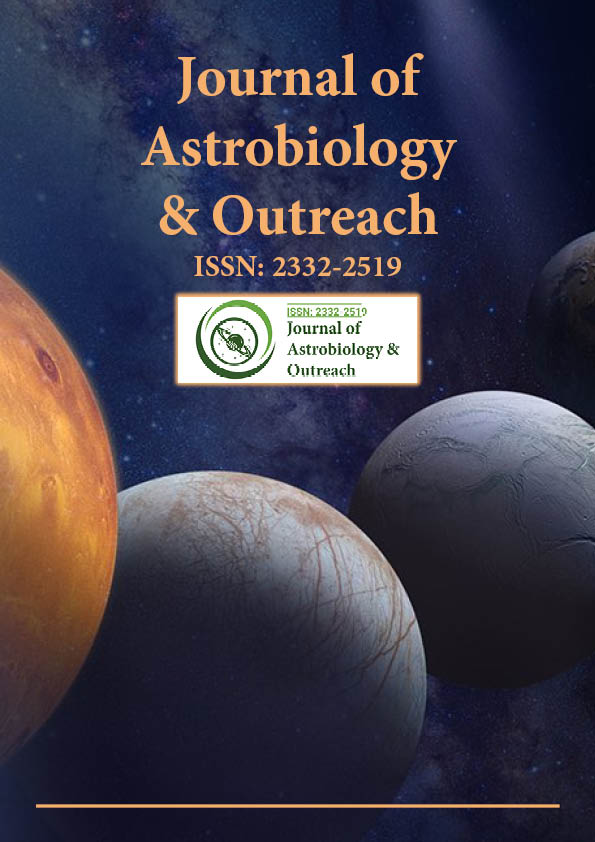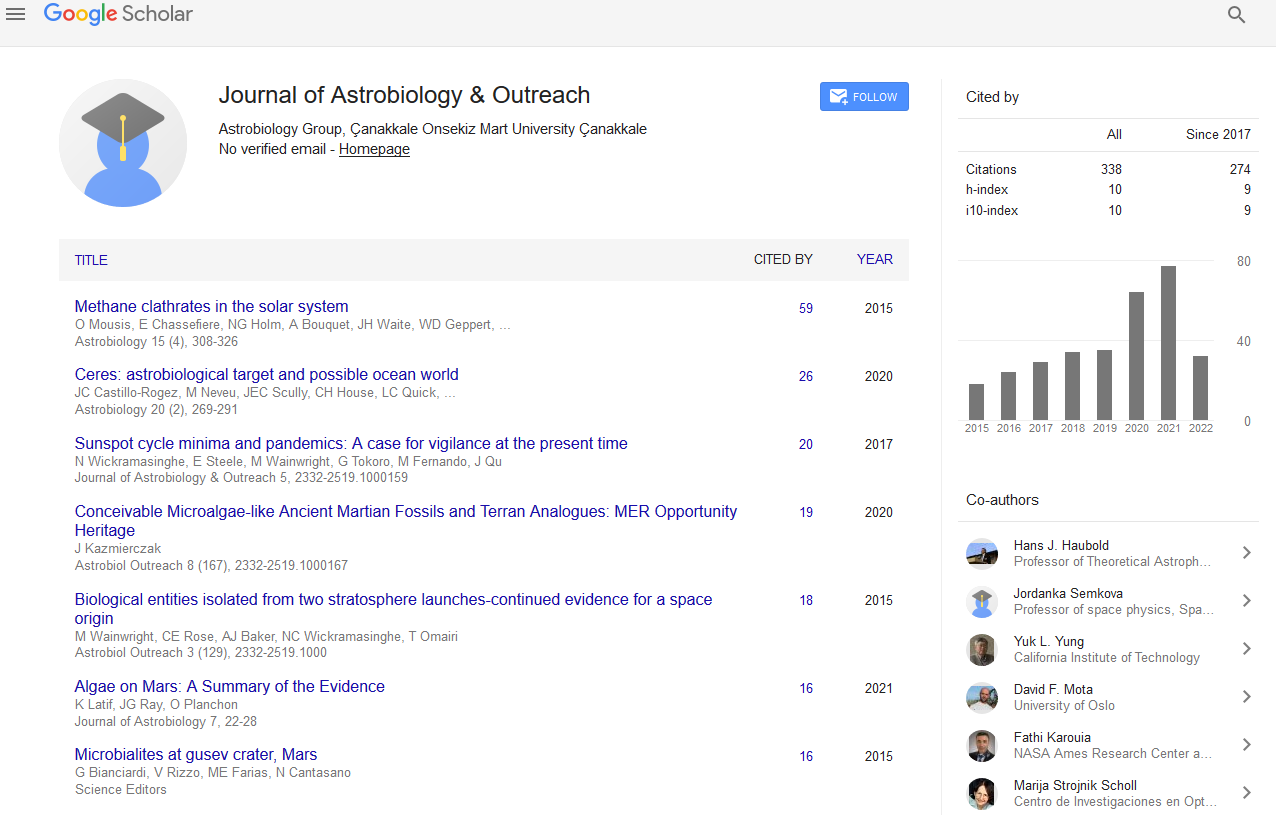Indexed In
- Open J Gate
- Academic Keys
- JournalTOCs
- RefSeek
- Hamdard University
- EBSCO A-Z
- OCLC- WorldCat
- Google Scholar
Useful Links
Share This Page
Journal Flyer

Open Access Journals
- Agri and Aquaculture
- Biochemistry
- Bioinformatics & Systems Biology
- Business & Management
- Chemistry
- Clinical Sciences
- Engineering
- Food & Nutrition
- General Science
- Genetics & Molecular Biology
- Immunology & Microbiology
- Medical Sciences
- Neuroscience & Psychology
- Nursing & Health Care
- Pharmaceutical Sciences
Perspective - (2023) Volume 11, Issue 3
Exploring Planetary Environments: Harnessing the Power of Time-Resolved Stand-Off UV-Raman Spectroscopy
Lien Zheng*Received: 01-May-2023, Manuscript No. JAO-23-21759; Editor assigned: 03-May-2023, Pre QC No. JAO-23-21759 (PQ); Reviewed: 17-May-2023, QC No. JAO-23-21759; Revised: 24-May-2023, Manuscript No. JAO-23-21759 (R); Published: 31-May-2023, DOI: 10.35248/2332-2519.23.11.302
About the Study
Planetary exploration has always been navigated to shown unravel the mysteries of celestial bodies beyond our own planet. With each mission, they strive to gather more information about distant worlds, the geological composition, and the potential for habitability. One of the key challenges in planetary exploration is the ability to analyze the surface and atmosphere of these celestial bodies remotely, without direct contact. In recent years, time-resolved stand-off UV-Raman Spectroscopy has emerged as a powerful tool in this pursuit, offering unprecedented insights into the composition and dynamics of planetary environments.
UV-Raman Spectroscopy is a technique that utilizes Ultraviolet (UV) light to probe the molecular vibrations and identify the chemical composition of materials. It provides a unique fingerprint that can help scientists understand the geological processes and potential presence of organic compounds on planetary surfaces. By combining this spectroscopic technique with time-resolved capabilities, scientists can capture dynamic changes and reactions occurring in real-time, opening up a new realm of possibilities for planetary exploration.
The application of time-resolved stand-off UV-Raman Spectroscopy in planetary exploration has the potential to revolutionize our understanding of the cosmos. Traditionally, planetary missions have relied on various remote sensing techniques, such as visible and infrared spectroscopy, to analyze the composition of celestial bodies. While these techniques have been successful to some extent, they often provide limited information about the molecular structure and dynamics of the materials being studied. Time-resolved stand-off UV-Raman Spectroscopy offers a distinct advantage by allowing scientists to investigate the temporal evolution of chemical reactions, providing crucial insights into the dynamics of planetary environments.
One of the key advantages of time-resolved stand-off UV-Raman Spectroscopy is its ability to analyze the surface and subsurface of planetary bodies from a distance. Here the scientists can obtain valuable data without the need for physical contact, which is particularly significant in extreme environments or locations that are challenging to access. The ability to conduct non-invasive measurements from a stand-off position allows for a more comprehensive understanding of the targeted celestial body, providing valuable information about its geological history, potential for habitability, and even the presence of life.
Moreover, the time-resolved aspect of this technique adds another layer of information that was previously inaccessible. By monitoring the temporal changes in the Raman Spectra, scientists can gain insights into the kinetics of chemical reactions, phase transitions, and the effects of external stimuli, such as solar radiation or atmospheric interactions. This capability is invaluable for understanding the complex and dynamic nature of planetary environments, where factors such as atmospheric composition, geological processes, and the presence of volatile substances play significant roles.
The potential applications of time-resolved stand-off UV-Raman Spectroscopy are vast. For example, on Mars, this technique could help determine the history of water on the planet's surface, investigate the potential for ancient microbial life, and monitor seasonal changes in the atmosphere. Similarly, on icy moons like Europa or Enceladus, time-resolved UV-Raman Spectroscopy could provide insights into the subsurface oceans, the presence of organic compounds, and the potential for hydrothermal activity. Additionally, this technique can be employed in the study of exoplanets, helping to identify potentially habitable worlds and assess their atmospheric dynamics.
However, it is important to note that the implementation of time-resolved stand-off UV-Raman Spectroscopy in planetary exploration is not without challenges. The technique requires advanced instrumentation capable of generating and analyzing UV light, as well as the ability to withstand the harsh conditions of space. Furthermore, the interpretation of the obtained spectra requires a deep understanding of the underlying physical and chemical processes.
Conclusion
Time-resolved stand-off UV-Raman Spectroscopy represents a significant advancement in the field of planetary exploration. Its ability to remotely probe the composition and dynamics of celestial bodies offers unprecedented opportunities for scientific discovery. By capturing real-time changes in Raman spectra, scientists can gain insights into the complex nature of planetary environments and potentially uncover the presence of organic compounds or signs of habitability. As this technology continues to evolve and improve, it holds immense potential for revolutionizing our understanding of the cosmos and the search for life beyond earth.
Citation: Zheng L (2023) Exploring Planetary Environments: Harnessing the Power of Time-Resolved Stand-Off UV-Raman Spectroscopy. J Astrobiol Outreach. 11:302.
Copyright: © 2023 Zheng L. This is an open-access article distributed under the terms of the Creative Commons Attribution License, which permits unrestricted use, distribution, and reproduction in any medium, provided the original author and source are credited.

